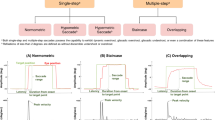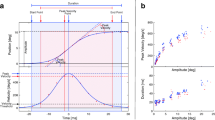Abstract
Fatigue is one of the most frequent and disabling symptoms in multiple sclerosis (MS). Its pathophysiology remains poorly understood and objective measures to quantify fatigue are unavailable to date. To investigate whether analysis of ocular motor movements can provide diagnostic information in MS patients with fatigue, 37 MS patients (21 female, age 44 ± 9 years) and 20 age- and gender-matched healthy controls were prospectively recruited. Fatigue was assessed with the fatigue severity scale (FSS). Twenty-five MS patients were fatigued (defined as FSS ≥4) and 12 MS patients were not. Subjects performed a saccadic fatigue task that required execution of uniform saccades over a period of 10 min. Saccadic amplitude, latency and peak velocities during the task were analysed and selected parameters were tested in a receiver operating characteristic (ROC) analysis. Fatigued patients showed a significantly larger decrease of saccadic peak velocity and amplitude when compared to patients without fatigue and healthy controls. Furthermore, fatigued patients showed significantly longer latencies compared to non-fatigued patients and healthy controls. Peak velocity change over time and latencies correlated with FSS scores. The best parameter to discriminate between fatigued and non-fatigued patients was peak velocity change over time (ROC; area under the curve = 0.857). Assessment of peak velocity, amplitude and latency in a saccade fatigue task is a promising approach for quantifying fatigue in MS patients.


Similar content being viewed by others
References
Minden S, Frankel D, Hadden L et al (2006) The Sonya Slifka Longitudinal Multiple Sclerosis Study: methods and sample characteristics. Mult Scler 12(1):24–38
Lerdal A, Celius E, Moum T (2003) Fatigue and its association with sociodemographic variables among multiple sclerosis patients. Mult Scler 9(5):509–514
Bakshi R (2003) Fatigue associated with multiple sclerosis: diagnosis, impact and management. Mult Scler 9(3):219–227
Krupp L (2006) Editorial. Mult Scler 12(4):367–368
Patrick E, Christodoulou C, Krupp LB (2009) Longitudinal correlates of fatigue in multiple sclerosis. Mult Scler 15(2):258–261
Smith MM, Arnett Pa (2005) Factors related to employment status changes in individuals with multiple sclerosis. Mult Scler 11(5):602–609
Téllez N, Río J, Tintoré M et al (2005) Does the modified fatigue impact scale offer a more comprehensive assessment of fatigue in MS? Mult Scler 11(2):198–202
Krupp LB, LaRocca NG, Muir-Nash J, Steinberg AD (1989) The fatigue severity scale. Application to patients with multiple sclerosis and systemic lupus erythematosus. Arch Neurol 46(10):1121–1123
Comi G, Leocani L, Rossi P, Colombo B (2001) Physiopathology and treatment of fatigue in multiple sclerosis. J Neurol 248(3):174–179
Krupp LB, Elkins LE (2000) Fatigue and declines in cognitive functioning in multiple sclerosis. Neurology 55(7):934–939
Flachenecker P, Kümpfel T, Kallmann B et al (2002) Fatigue in multiple sclerosis: a comparison of different rating scales and correlation to clinical parameters. Mult Scler 8(6):523–526
Weinges-Evers N, Brandt AU, Bock M et al (2010) Correlation of self-assessed fatigue and alertness in multiple sclerosis. Mult Scler 16(9):1134–1140
Morrow SA, Weinstock-Guttman B, Munschauer FE, Hojnacki D, Benedict RHB (2009) Subjective fatigue is not associated with cognitive impairment in multiple sclerosis: cross-sectional and longitudinal analysis. Mult Scler 15(8):998–1005
Bailey A, Channon S, Beaumont JG (2007) The relationship between subjective fatigue and cognitive fatigue in advanced multiple sclerosis. Mult Scler 13(1):73–80
Schwid SR, Thornton CA, Pandya S et al (1999) Quantitative assessment of motor fatigue and strength in MS. Neurology 53(4):743–750
Matta M, Leigh RJ, Pugliatti M, Aiello I, Serra A (2009) Using fast eye movements to study fatigue in multiple sclerosis. Neurology 73(10):798–804
Polman CH, Reingold SC, Edan G et al (2005) Diagnostic criteria for multiple sclerosis : 2005 revisions to the “McDonald Criteria”. Ann Neurol 11:840–846
Kurtzke JF (1983) Rating neurologic impairment in multiple sclerosis: an expanded disability status scale (EDSS). Neurology 33(11):1444–1452
Cutter GR, Baier ML, Rudick RA et al (1999) Development of a multiple sclerosis functional composite as a clinical trial outcome measure. Brain 122(5):871–882
Kos D, Nagels G, D’Hooghe MB, Duportail M, Kerckhofs E (2006) A rapid screening tool for fatigue impact in multiple sclerosis. BMC Neurol 6:27
Beck AT, Steer RA (1984) Internal consistencies of the original and revised Beck Depression Inventory. J Clin Psychol 40(6):1365–1367
Leigh RJ, Zee DS (2006) The neurology of eye movements. Oxford University Press, Oxford
Brunner E, Domhof S, Langer F (2002) Nonparametric analysis of longitudinal data in factorial experiments. Wiley, New York
R Development Core Team RFFSC (2008) R: a language and environment for statistical computing. R foundation for statistical computing, Vienna. 1(10): ISBN 3-900051-07-0. Available at: http://www.r-project.org
Frohman EM, Frohman TC, Zee DS, McColl R, Galetta S (2005) The neuro-ophthalmology of multiple sclerosis. Lancet Neurol 4(2):111–121
Downey DL, Stahl JS, Bhidayasiri R et al (2002) Saccadic and vestibular abnormalities in multiple sclerosis: sensitive clinical signs of brainstem and cerebellar involvement. Ann NY Acad Sci 956(4):438–440
Straube A, Robinson FR, Fuchs AF (1997) Decrease in saccadic performance after many visually guided saccadic eye movements in monkeys. Investig Ophthalmol Vis Sci 38(13):2810–2816
Prsa M, Dicke PW, Thier P (2010) The absence of eye muscle fatigue indicates that the nervous system compensates for non-motor disturbances of oculomotor function. J Neurosci 30(47):15834–15842
Flachenecker P, Meissner H (2008) Fatigue in multiple sclerosis presenting as acute relapse: subjective and objective assessment. Mult scler 14(2):274–277
Bo J, Block HJ, Clark JE, Bastian AJ (2008) A cerebellar deficit in sensorimotor prediction explains movement timing variability. J Neurophysiol 100(5):2825–2832
Bares M, Lungu O, Liu T et al (2007) Impaired predictive motor timing in patients with cerebellar disorders. Exp Brain Res 180(2):355–365
Zimmermann P, Fimm B (2002) A test battery for attentional performance. In: Leclercq M, Zimmermann P (eds) Applied neuropsychology of attention: theory, diagnosis and rehabilitation. Psychology Press, London, pp 110–151
Möller F, Poettgen J, Broemel F et al (2011) HAGIL (Hamburg Vigil Study): a randomized placebo-controlled double-blind study with modafinil for treatment of fatigue in patients with multiple sclerosis. Mult scler 17(8):1002–1009
Stankoff B, Waubant E, Confavreux C et al (2005) Modafinil for fatigue in MS: a randomized placebo-controlled double-blind study. Neurology 64(7):1139–1143
Rammohan KW, Rosenberg JH, Lynn DJ et al (2002) Efficacy and safety of modafinil (Provigil) for the treatment of fatigue in multiple sclerosis: a two centre phase 2 study. J Neurol Neurosurg Psychiatry 72(2):179–183
Prins JB, van der Meer JWM, Bleijenberg G (2006) Chronic fatigue syndrome. Lancet 367(9507):346–355
Frohman TC, Frohman EM, O’Suilleabhain P et al (2003) Accuracy of clinical detection of INO in MS: corroboration with quantitative infrared oculography. Neurology 61(6):848–850
Acknowledgments
This study was supported by a grant from German Research Foundation (DFG Exc. 257).
Conflicts of interest
There is no conflict of interest from any author regarding this study.
Ethical standard
This study has been approved by the appropriate ethics committee and has been performed in accordance with the ethical standards laid down in the 1964 Declaration of Helsinki.
Author information
Authors and Affiliations
Corresponding author
Additional information
C. Finke and L. M. Pech are equally contributing first authors.
Electronic supplementary material
Below is the link to the electronic supplementary material.
Rights and permissions
About this article
Cite this article
Finke, C., Pech, L.M., Sömmer, C. et al. Dynamics of saccade parameters in multiple sclerosis patients with fatigue. J Neurol 259, 2656–2663 (2012). https://doi.org/10.1007/s00415-012-6565-8
Received:
Revised:
Accepted:
Published:
Issue Date:
DOI: https://doi.org/10.1007/s00415-012-6565-8




